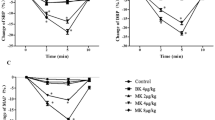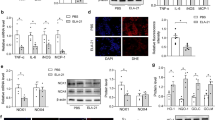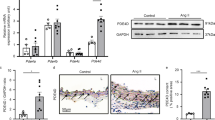Abstract
We detect the antihypertensive effects of maximakinin (MK) on renal hypertensive rats (RHRs) and further research the influence of MK on vascular smooth muscle cells (VSMCs) to explore its hypotensive mechanism. The effects of MK on arterial blood pressure were observed in RHRs. 3-(4,5-Dimethylthiazol-2-yl)-2,5-diphenyltetrazoliumbromide (MTT) assays were performed to detect the effect of MK on VSMC viability. Western blot and flow cytometry were used to investigate the influence of MK on intracellular Ca2+ levels and protein expression changes in VSMCs. In addition, specific protein inhibitors were applied to confirm the involvement of Ca2+-related signaling pathways induced by MK in VSMCs. MK showed a more significant antihypertensive effect than bradykinin in RHRs. MK significantly decreased intracellular Ca2+ concentrations. Furthermore, MK significantly induced the phosphorylation of signaling molecules, including extracellular signal-regulated kinase 1/2 (ERK1/2), P38, AMP-activated protein kinase (AMPK) and Akt in VSMCs. Moreover, only ERK1/2 inhibitor U0126 and AMPK inhibitor Compound C completely restored the decreased intracellular Ca2+ level induced by MK, and further research demonstrated that AMPK functioned upstream of ERK1/2 following exposure to MK. Finally, HOE-140, an inhibitor of the bradykinin B2 receptors (B2Rs), was applied to investigate the potential targets of MK in VSMCs. HOE-140 significantly blocked the AMPK/ERK1/2 pathway induced by MK, suggesting that the B2Rs might play an important role in MK-induced AMPK and ERK1/2 activation. MK significantly reduces blood pressure in RHRs. MK exerts its antihypertensive effect by activating the B2Rs and downstream AMPK/ERK1/2 pathways, leading to significantly reduced Ca2+ levels in VSMCs.

This is a preview of subscription content, access via your institution
Access options
Subscribe to this journal
Receive 12 print issues and online access
$259.00 per year
only $21.58 per issue
Buy this article
- Purchase on Springer Link
- Instant access to full article PDF
Prices may be subject to local taxes which are calculated during checkout







Similar content being viewed by others
References
Chen T, Bjourson AJ, McClean S, Orr DF, O’Kane EJ, Rao P, et al. Cloning of maximakinin precursor cDNAs from Chinese toad, Bombina maxima, venom. Peptides 2003;24:853–61.
Sharma JN. Hypertension and the bradykinin system. Curr Hypertens Rep. 2009;11:178–81.
O’Rourke M, Chen T, Hirst DG, Rao P, Shaw C. The smooth muscle pharmacology of maximakinin, a receptor-selective, bradykinin-related nonadecapeptide from the venom of the Chinese toad, Bombina maxima. Regul Pept. 2004;121:65–72.
Bawolak MT, Roy C, Gera L, Marceau F. Prolonged signalling and trafficking of the bradykinin B2 receptor stimulated with the amphibian peptide maximakinin: insight into the endosomal inactivation of kinins. Pharm Res. 2012;65:247–53.
Yu Y, Xu LS, Wu Y, Su FF, Zhou XM, Xu C. The antihypertensive effect of MK on spontaneously hypertensive rats through the AMPK/Akt/eNOS/NO and ERK1/2/Cx43 signaling pathways. Hypertens Res. 2021;44:781–90.
Misarkova E, Behuliak M, Bencze M, Zicha J. Excitation-contraction coupling and excitation-transcription coupling in blood vessels: their possible interactions in hypertensive vascular remodeling. Physiol Res. 2016;65:173–91.
Matchkov VV, Kudryavtseva O, Aalkjaer C. Intracellular Ca(2)(+) signalling and phenotype of vascular smooth muscle cells. Basic Clin Pharm Toxicol. 2012;110:42–48.
Luo J. Autophagy and ethanol neurotoxicity. Autophagy 2014;10:2099–108.
Lin S, Li X, Zhang J, Zhang Y. Omentin-1: Protective impact on ischemic stroke via ameliorating atherosclerosis. Clin Chim Acta. 2021;517:31–40.
Zhang SM, Jiang L, Zhao X, Liu JF, Liang B, Liu C, et al. A disintegrin and metalloprotease 22 accelerates neointima formation by activating ERK signaling. Atherosclerosis 2019;283:92–99.
Ortmann J, Veit M, Zingg S, Di Santo S, Traupe T, Yang Z, et al. Estrogen receptor-alpha but not -beta or GPER inhibits high glucose-induced human VSMC proliferation: potential role of ROS and ERK. J Clin Endocrinol Metab. 2011;96:220–8.
Waldman BM, Augustyniak RA, Chen H, Rossi NF. Effects of voluntary exercise on blood pressure, angiotensin II, aldosterone, and renal function in two-kidney, one-clip hypertensive rats. Integr Blood Press Control. 2017;10:41–51.
Sporkova A, Ghosh S, Al-Hasani J, Hecker M. Lin11-Isl1-Mec3 domain proteins as mechanotransducers in endothelial and vascular smooth muscle cells. Front Physiol. 2021;12:769321.
Shi J, Yang Y, Cheng A, Xu G, He F. Metabolism of vascular smooth muscle cells in vascular diseases. Am J Physiol Heart Circ Physiol. 2020;319:H613–H631.
Morales-Quinones M, Ramirez-Perez FI, Foote CA, Ghiarone T, Ferreira-Santos L, Bloksgaard M, et al. LIMK (LIM Kinase) inhibition prevents vasoconstriction- and hypertension-induced arterial stiffening and remodeling. Hypertension 2020;76:393–403.
Touyz RM, Alves-Lopes R, Rios FJ, Camargo LL, Anagnostopoulou A, Arner A, et al. Vascular smooth muscle contraction in hypertension. Cardiovasc Res. 2018;114:529–39.
Khaddaj Mallat R, Mathew John C, Kendrick DJ, Braun AP. The vascular endothelium: A regulator of arterial tone and interface for the immune system. Crit Rev Clin Lab Sci. 2017;54:458–70.
Feletou M, Kohler R, Vanhoutte PM. Nitric oxide: orchestrator of endothelium-dependent responses. Ann Med. 2012;44:694–716.
Ikebe M. Regulation of the function of mammalian myosin and its conformational change. Biochem Biophys Res Commun. 2008;369:157–64.
Walsh MP. Vascular smooth muscle myosin light chain diphosphorylation: mechanism, function, and pathological implications. IUBMB Life. 2011;63:987–1000.
Garcia-Redondo AB, Briones AM, Martinez-Revelles S, Palao T, Vila L, Alonso MJ, et al. c-Src, ERK1/2 and Rho kinase mediate hydrogen peroxide-induced vascular contraction in hypertension: role of TXA2, NAD(P)H oxidase and mitochondria. J Hypertens. 2015;33:77–87.
Yoshizumi M, Zhao J, Kyotani Y. [Vascular smooth muscle cell response to cyclic mechanical stretch and aortic dissection]. Nihon Yakurigaku Zasshi. 2018;151:155–9.
Li KX, Du Q, Wang HP, Sun HJ. Death-associated protein kinase 3 deficiency alleviates vascular calcification via AMPK-mediated inhibition of endoplasmic reticulum stress. Eur J Pharm. 2019;852:90–98.
Li FF, Shang XK, Du XL, Chen S. Rapamycin treatment attenuates angiotensin II-induced abdominal aortic aneurysm formation via VSMC phenotypic modulation and down-regulation of ERK1/2 activity. Curr Med Sci. 2018;38:93–100.
Ghasempour G, Mohammadi A, Zamani-Garmsiri F, Najafi M. miRNAs through beta-ARR2/p-ERK1/2 pathway regulate the VSMC proliferation and migration. Life Sci. 2021;279:119703.
Chen QW, Edvinsson L, Xu CB. Role of ERK/MAPK in endothelin receptor signaling in human aortic smooth muscle cells. BMC Cell Biol. 2009;10:52.
Chen NX, O’Neill KD, Moe SM. Matrix vesicles induce calcification of recipient vascular smooth muscle cells through multiple signaling pathways. Kidney Int. 2018;93:343–54.
Hardie DG, Ross FA, Hawley SA. AMPK: a nutrient and energy sensor that maintains energy homeostasis. Nat Rev Mol Cell Biol. 2012;13:251–62.
Hwang YJ, Cho DH. Activation of AMPK/proteasome/MLCK degradation signaling axis by telmisartan inhibits VSMC contractility and vessel contraction. Biochem Biophys Res Commun. 2020;524:853–60.
Mount PF, Lane N, Venkatesan S, Steinberg GR, Fraser SA, Kemp BE, et al. Bradykinin stimulates endothelial cell fatty acid oxidation by CaMKK-dependent activation of AMPK. Atherosclerosis 2008;200:28–36.
Woods A, Dickerson K, Heath R, Hong SP, Momcilovic M, Johnstone SR, et al. Ca2+/calmodulin-dependent protein kinase kinase-beta acts upstream of AMP-activated protein kinase in mammalian cells. Cell Metab. 2005;2:21–33.
Hu L, Su L, Dong Z, Wu Y, Lv Y, George J, et al. AMPK agonist AICAR ameliorates portal hypertension and liver cirrhosis via NO pathway in the BDL rat model. J Mol Med (Berl). 2019;97:423–34.
Dong Z, Su L, Esmaili S, Iseli TJ, Ramezani-Moghadam M, Hu L, et al. Adiponectin attenuates liver fibrosis by inducing nitric oxide production of hepatic stellate cells. J Mol Med (Berl). 2015;93:1327–39.
Tong S, Zhou T, Meng Y, Xu D, Chen J. AMPK decreases ERK1/2 activity and cancer cell sensitivity to nutrition deprivation by mediating a positive feedback loop involving eEF2K. Oncol Lett. 2020;20:61–66.
Liu Y, Lu Z, Cui M, Yang Q, Tang Y, Dong Q. Tissue kallikrein protects SH-SY5Y neuronal cells against oxygen and glucose deprivation-induced injury through bradykinin B2 receptor-dependent regulation of autophagy induction. J Neurochem. 2016;139:208–20.
Acknowledgements
We thank Melissa Crawford, PhD, from Liwen Bianji (Edanz) (www.liwenbianji.cn/), for editing the English text of a draft of this manuscript.
Funding
None.
Author information
Authors and Affiliations
Contributions
CX and YY designed the research. YY, X-QW, YW, F-FS, and C-FY performed the research. CX contributed new reagents or analytical tools. X-QW and X-MZ analyzed the data. YY and CX wrote the paper.
Corresponding author
Ethics declarations
Conflict of interest
The authors declare no competing interests.
Additional information
Publisher’s note Springer Nature remains neutral with regard to jurisdictional claims in published maps and institutional affiliations.
Rights and permissions
Springer Nature or its licensor (e.g. a society or other partner) holds exclusive rights to this article under a publishing agreement with the author(s) or other rightsholder(s); author self-archiving of the accepted manuscript version of this article is solely governed by the terms of such publishing agreement and applicable law.
About this article
Cite this article
Yu, Y., Wu, Xq., Su, Ff. et al. Maximakinin reduced intracellular Ca2+ level in vascular smooth muscle cells through AMPK/ERK1/2 signaling pathways. Hypertens Res 46, 1949–1960 (2023). https://doi.org/10.1038/s41440-023-01330-x
Received:
Revised:
Accepted:
Published:
Issue Date:
DOI: https://doi.org/10.1038/s41440-023-01330-x



